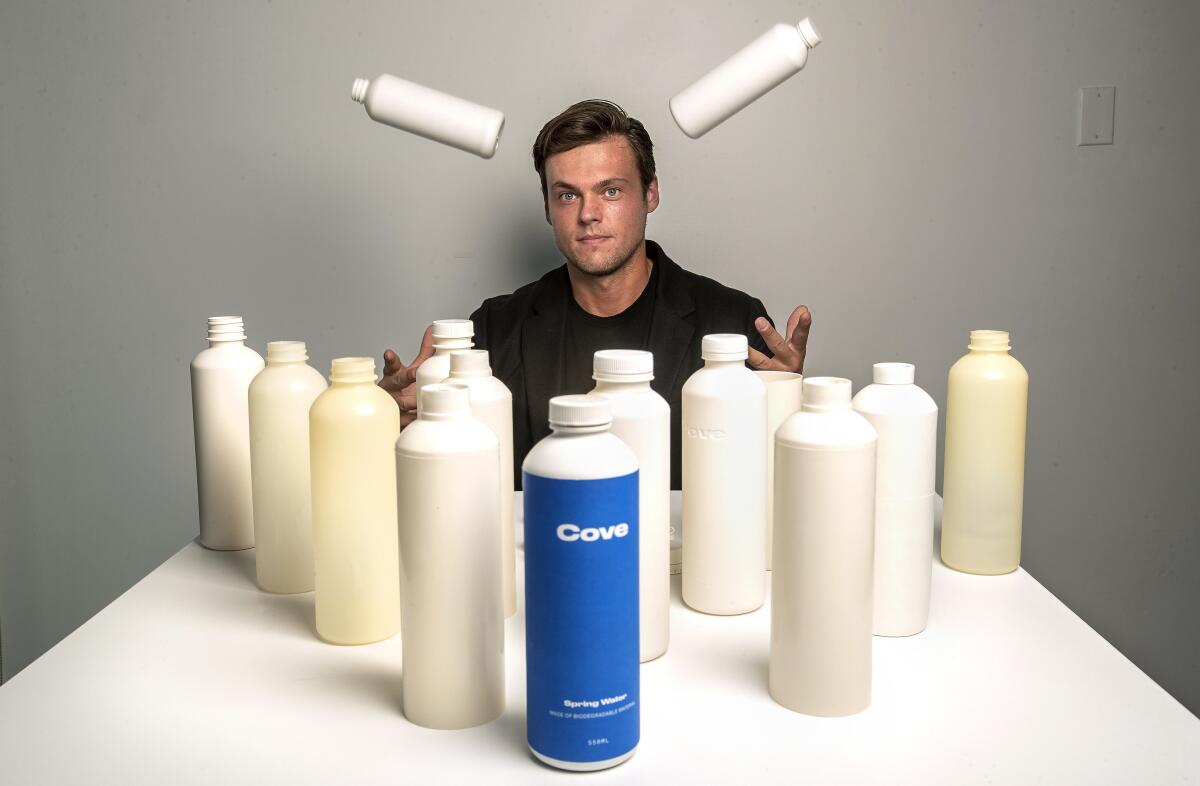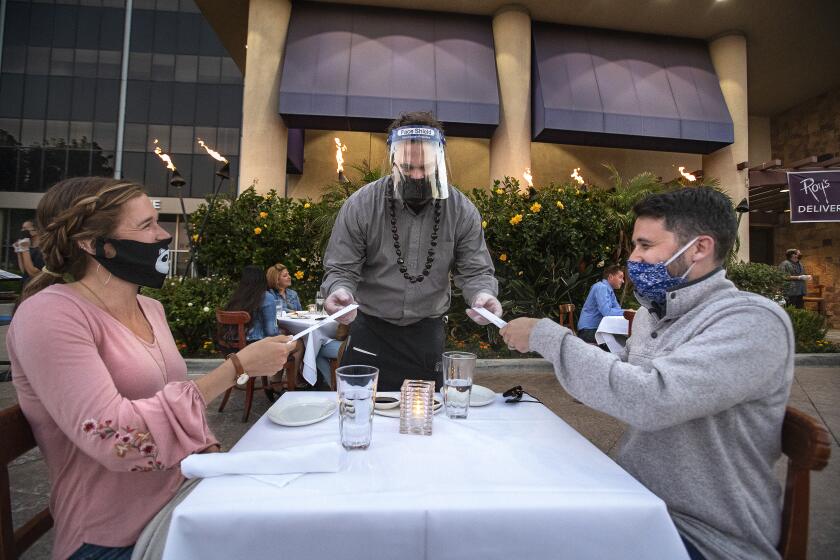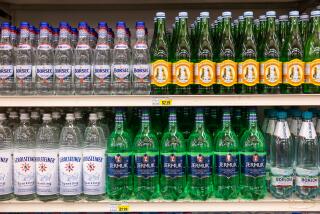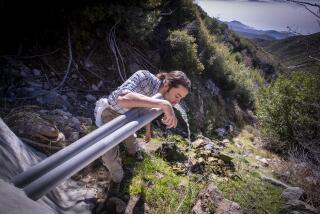Building a guilt-free disposable water bottle: It’s not easy

- Share via
Does the world really need another brand of bottled water?
Alex Totterman believes it does, if the packaging is completely biodegradable.
For the record:
12:43 p.m. Oct. 6, 2020An earlier version of this article identified actor Leonardo DiCaprio as being among the backers of Cove. DiCaprio is not an investor in the company.
And his Culver City start-up, Cove, has the backing of some environmentally woke business leaders, including Salesforce Chief Executive Marc Benioff and former News Corp. executive James Murdoch, who has invested a tiny but undisclosed portion of the approximately $2 billion he netted when his family sold most of 21st Century Fox to Walt Disney Co.
Cove’s new water bottle, which is scheduled to get a small pilot launch in December and hit store shelves more broadly in January, is the first to be made entirely from biodegradable materials, the company contends, including the bottle cap, label and adhesive.
The path toward a fully biodegradable product hasn’t been easy, Totterman said, but is important given the abundance of plastic waste in every part of the environment, even in places where humans seldom tread. Cove is up against criticism that less chic options, such as tap water, are a better environmental choice than having your H2O shipped from some natural spring in another state or from halfway around the world.
“Plastic bottle beverages are the kind of single-use products that we should be moving away from most aggressively,” said Alex Truelove, director of the Zero Waste Campaign for the U.S. Public Interest Research Group. “The metaphor I’ve used most often is, ‘If your bathtub is overflowing, the first thing you do is turn off the tap.’”
But no one is turning off the tap, said Totterman, who founded Cove in 2017 to address the expanding plastic problem. Cove’s sustainable and biodegradable packaging is meant to provide a less dubious retail alternative, Totterman said, as recycling programs have failed to handle what the industry turns out.
“There’s been no sign of it slowing down,” he said. “In fact, it looks like the industry is going to be making more and more plastic bottles.”
Some of the world’s biggest brands have made voluntary pledges to reduce plastic packaging and to include an average of 25% recycled content in their plastic packaging by 2025, but progress has been slow, according to a report published last year by the Ellen MacArthur Foundation and the U.N. Environment Program.
Most brands are stuck in the low single digits, according to the foundation, which famously forecast in 2016 that plastic would outweigh fish in the oceans by 2050. At the time of the report, L’Oreal said that 5% of its plastic packaging was recycled material. PepsiCo said it was at 3%. Nestle was at 2%. The highest was Coca-Cola Co.‘s 9%.
Totterman, who previously worked at a nanotechnology start-up that focused on water purification for industrial applications and wastewater treatment, said he hadn’t been especially interested in plastics — he simply couldn’t avoid them.
“Microplastics were everywhere,” Totterman said, “literally raining down on us, and it’s very alarming. And plastic water bottles, which should seem like such an antiquated idea in a world where we are so aware of the problem we have ... are running rampant.”
Activists worry that all those coronavirus masks, medical kits, takeout containers and grocery bags are setting back a global fight to curb single-use plastic.
First, Totterman said, the company had to come up with a material to use for the bottle. He also needed to boost the scientific credentials of Cove’s small staff and turned to a recognized biomaterials expert named Jan Ravenstijn.
“We brought on board one of the leading global PHA scientists as our chief science advisor,” Totterman said. “He’s been in R&D at Dow Chemical and the huge traditional polymer companies for the last 20, 30 years, and is now partly retired, but he is still helping us.”
The search for the perfect raw material for all the bottle’s components has “really taken three years of research and development,” he said. “We looked at every kind of natural material out there.... And really, it turns out there’s only a few polymers that are fully biodegradable and naturally occurring.”
In 2018, Totterman said, he found a supplier in Athens, Ga., for a type of bio-waste polymer called PHAs, or polyhydroxyalkanoates, in pellet form, which would be melted down to make bottles using Cove’s equipment at a third-party bottler in Montebello. (Whether PHAs are plastic has become a thorny issue for makers of single-use items, with a ruling expected this year by the European Council.)
Many hurdles remained: It wasn’t going to be as simple as picking a design and telling the bottler to make it, Totterman said. He didn’t see the point of producing a biodegradable bottle with an indestructible, hard plastic cap, a regular label and toxic adhesives.
“Everything had to start from scratch, Totterman said. “We don’t even actually use a normal label. We have a cellulose label that is applied to the bottle with biodegradable adhesive, so everything about this bottle is sustainable.”
The estimated amount of time needed to break down the bottle varies based on where it ends up: less than a year in home compost, less than three months in industrial compost and less than five years in the ocean or an open landfill, Totterman said. In a landfill that’s been capped, the process would take longer.
Appalled by the tidal wave of single-use plastic from takeout and more? Experts give tips for how to be eco-friendly during the COVID-19 pandemic.
Using PHAs creates a marketing hurdle. PHAs are opaque, but “consumers want to see what’s in the bottle,” said Adam Smith, a USC professor of environmental engineering and head of the Smith Research Group, which works on engineering systems for water management, wastewater management and water reuse.
Smith was open to the idea of Cove’s biodegradable packaging, even if he thought such a bottle shouldn’t be necessary. “I think we should be drinking water out of the tap. Of course, I’m anti-bottled water, but if there’s better biodegradable plastic or cardboard bottles of water, then I’m all for that.”
Totterman agreed that “people have become used to seeing their water through that container, but it is as much marketing as anything else. So we think that consumer perception can change with that.”
Cove isn’t the first company to take the opaque, trust-us-it’s-good route. In 2019, All Market Inc., the New York parent company for Vita Coco coconut water and the energy drink Runa, introduced Ever & Ever, drinking water sold in an all-aluminum can.
Another obstacle that Totterman’s company may face in winning converts is environmental exhaustion.
Americans have dutifully sorted out recyclable materials for years, only to be told that recycling in some instances has stopped working, and too many recyclable materials are winding up in landfills. Recycling plastic isn’t as simple as recycling something like aluminum, which is easily turned into new products, PIRG’s Truelove said.
“It’s always been a square-peg, round-hole kind of situation,” Truelove said. “The small percentage of plastics that are recycled” are lucky alignments “of a product that can really be made into something else, like a bottle into a carpet.”
Totterman said he picked California for his company headquarters in part because of an absence of the kind of jaded sentiment that suggests recycling has been a failure.
“California is a leader in sustainability. The Great Pacific Garbage Patch is the largest of the plastic waste accumulations, and it’s right between the West Coast and Hawaii, so California is aware, and it’s greatly affected by this issue, and it’s a leader in clean energy and renewables,” Totterman said, “so I’m really optimistic about what we can do here.”
The water, Totterman said, will be “purified alkaline water that’s sustainably sourced. We’re not using spring water. We’re not sourcing in any drought-stricken areas.”
As currently planned, a 20-ounce bottle will cost $2.29. He said negotiations were ongoing with several store chains, although Whole Foods is the only one he can reveal at the moment.
“We’re hoping people are more interested in doing the right thing sustainably” and will try Cove, he said, “especially if we can make it close enough in cost to the price they are paying for water now.”
More to Read
Inside the business of entertainment
The Wide Shot brings you news, analysis and insights on everything from streaming wars to production — and what it all means for the future.
You may occasionally receive promotional content from the Los Angeles Times.











